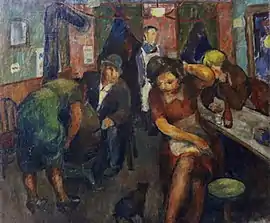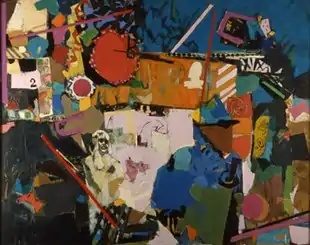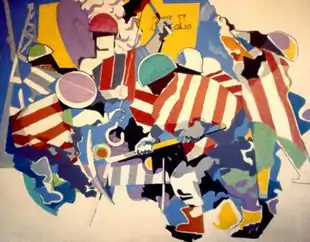Sam Himmelfarb | |
|---|---|
| Born | July 4, 1904 |
| Died | December 17, 1976 (aged 72) Chicago, Illinois, US |
| Nationality | American |
| Education | Art Students League of New York, National Academy of Design, Wisconsin School of Fine and Applied Arts |
| Known for | Painting, exhibit design |
| Style | Modernism, Realism, Figurative |
| Spouse(s) | Irene Donnelly (1926–1937); Eleanor Gorecki Himmelfarb (1939–1976) |
| Website | Sam Himmelfarb |
Sam Himmelfarb (July 4, 1904 – December 17, 1976) was a Russian Empire-born, American artist and commercial exhibit designer, known for his modernist-influenced paintings of everyday people and urban scenes.[1][2][3] He also designed the Frank Lloyd Wright-inspired Samuel and Eleanor Himmelfarb Home and Studio (built, 1942) in Winfield, Illinois, which is listed on the National Register of Historic Places.[4][5] Himmelfarb studied art at the Art Students League and National Academy of Design in New York and at the Wisconsin School of Fine and Applied Arts.[6][7] He initially painted in a realist style influenced by the Ashcan School, which gave way to more modernist, increasingly abstract styles.[8] His paintings appeared in exhibitions at the Art Institute of Chicago (AIC),[9][10] Terra Museum of American Art,[11] Milwaukee Art Institute, and Arts Club of Chicago, and in circulating shows from the American Federation of Arts, among other venues.[12] He received awards from the AIC, Wisconsin State Fair and Milwaukee Art Museum, and his work belongs to the collection of the latter, and those of the Illinois State Museum, Block Museum, and Arkansas Art Center, among others.[13][14][15] Himmelfarb was married to the artist and educator, Eleanor Himmelfarb (1910-2009); their son, John Himmelfarb (b. 1946), and grandchild, Serena Aurora Day Himmelfarb (b. 1986), are also artists.[16]
Life

Samuel Himmelfarb was born in Latvia to Jewish parents in 1904. In 1905, they immigrated to the United States, but soon after, Himmelfarb's mother died during childbirth in New York City. He and his father, Chaim, moved on to Wisconsin, settling in Racine and then Milwaukee.[6][3] Himmelfarb took weekend art classes at the Layton School of Art and attended an art summer camp, meeting lifelong friend and future WPA muralist, Schomer Lichtner.[17][18][19] In high school, he learned to play the drums and by the early 1920s was performing semi-professionally in local vaudeville acts, dance music ensembles, and on a Pacific cruise ship; large crowds and musicians would later serve as subjects for many of his paintings.[20][21][4]
After high school, Himmelfarb studied art at the University of Wisconsin–Madison (1924)—forging relationships with artists such as Ben Shahn—and at the Wisconsin School of Fine and Applied Arts, working under German-born landscape artist Gustave Moeller.[22][18][7] In 1926, he hitchhiked to New York to study at the National Academy of Design and the Art Students League, where he took classes, respectively, with artists Charles Webster Hawthorne and Boardman Robinson, and was influenced by the older Ashcan School artists.[6][23][24] He supported himself with two jobs, as a drummer—playing a 16-show run for big band leader Horace Heidt and gigs with Jimmy Durante—and an architect's apprentice on projects for Long Island homes and the Empire State Building.[23] He also met and married Irene Donnelly in 1926, and they had a daughter, Nell, in 1933.[4] They moved to the Midwest in the 1930s, and Himmelfarb focused on commercial three-dimensional design work, creating window displays for Mandel Brothers department store and exhibits for the 1933 A Century of Progress Exposition in Chicago.[23][6] In 1937, he founded his own industrial exhibit company, Three Dimensions, which would support a fine art career that he pursued painting three days each week; exhibit clients included Union Pacific Railroad, Parker Brothers, General Motors, and Motorola, among others.[25][18][12] By this time, Himmelfarb's marriage had become strained and that same year he and Irene divorced.[4]
Himmelfarb was part of a socially conscious group of Midwest modernists that included Mitchell Siporin, Julio de Diego, Macena Barton, and Milwaukee-based Joseph Friebert,[26] among others.[4] He was active in antifascist groups and in the Arts Club of Chicago and Artists Equity (serving as president in the 1950s);[6] he often delivered lectures to civic groups, such as “Don’t Look Now, But Your Modern Art is Showing.”[21] At a Hyde Park activist meeting in the late 1930s, Himmelfarb met Eleanor Gorecki. Their relationship became serious, and he and Gorecki married in 1939, remaining so until Sam's death in 1976.[16] In 1940, they purchased an undeveloped property in a not-yet residential section of rural Winfield, Illinois, planning to settle there and raise a family closer to nature. By late 1942, they built and moved into a self-designed, Usonian-style house there, now listed on the National Register of Historic Places.[5][4] In the following years, they had two children, Susan (b. 1943) and John (b. 1946).[25]
Art career

Himmelfarb's art evolved throughout his five-decade career, from Ashcan School-influenced urban realism in the 1920s, through more expressionist work in the 1940s and 1950s, to increasingly abstract paintings in the 1960s and 1970s that incorporated Abstract expressionist and Pop influences.[8][1][6] Certain concerns, however, remained consistent in his work: a modernist visual aesthetic dedicated to the notion of the integrated artwork; subject matter rooted, even in his more abstract work, to narrative and the objective world; and a preoccupation with scenes celebrating ordinary people and everyday life.[8][27][1] Curator Rene Paul Barilleaux suggests that Himmelfarb engages viewers through common, recognizable experiences "transformed into dynamically rendered and visually charged images."[8] In interviews, Himmelfarb explained, "I record the unprogrammed, the unglorified, the casual human scene […] a tune in praise of the unspectacular.”[1][21][22]
Himmelfarb exhibited widely from the 1920s through the 1950s, at the Wisconsin Painters and Sculptors Exhibitions (early 1920s, 1938),[28][22] shows at the Arts Club of Chicago (1952–9) and Renaissance Society (1958), and national and international circulating shows organized by the American Federation of Arts (1953) and Art Institute of Chicago (1958–9, curated by Katharine Kuh).[23][29][12] He was selected for numerous Art Institute of Chicago invitational and "Chicago and Vicinity" shows (1936–1957), including its 1951 "Annual American Exhibition."[30][31][32][33][34][12] In 1949, he won the museum's Broadus James Clarke Memorial Prize for his casein work, Men on a Boat.[13][35] Notable solo shows were held for Himmelfarb at the Milwaukee Art Institute (1932), Panoras Gallery (New York, 1956),[36] Frank Ryan Gallery (Chicago, 1958), and Charles Allis Art Museum (Milwaukee, 1969).[22][21][12][2]
In the 1970s, Himmelfarb showed with his wife Eleanor and son John at the Bradley Gallery (Milwaukee, 1974) and Chicago's One Illinois Center (1975).[37][38][39] They were also exhibited together in later shows at the Evanston Art Center (1990) and Quincy Art Center (1994).[40][12] More recently, Himmelfarb's work has been featured in the surveys, "Chicago Modern, 1893-1945: Pursuit of the New" (Terra Museum, 2004) and "Figurism: Narrative and Fantastic Figurative Art from the Illinois State Museum Collection" (2012).[11][14]
Work and reception
Art historians often compare Himmelfarb's early work of the 1920s and 1930s to that of Ashcan school artists, such as John Sloan.[6][1] Discussing Himmelfarb’s painting, Road House (1927), Patricia Smith Scanlan identifies its similar "dark-toned urban realism" and informal setting—a humble roadside bar populated with disinterested subjects—while also noting the subtle influence of French modernism in its plunging perspective, strong lighting effects, and loose brushwork.[6][1][41] In Chicago Modern, 1893-1945: Pursuit of the New, Amy Galpin and Susan Weininger suggest that Himmelfarb's rapid brushwork and spontaneous paint application portray the "vitality and dynamism of the modern city."[1]

Himmelfarb's work of the 1940s retained his interest in observing and recording everyday life, but increasingly, displayed a greater emphasis on formal aspects over representation.[6] For example, in L (1941)[42] and Commuters (1945)[43]—which depicts four men playing cards on their way to work—critics note modernist features such as flattened space, bold outlines, and blocky, unmodulated areas of color that create a Cézanne-like play of geometric shapes on the heads and bodies of figures and their surroundings.[8][6]

In his 1950s, Himmelfarb continued to focus on crowds, such as audiences, commuters and beachgoers. However, in paintings such as Poet and Paysano (1950), Front Row at the Beach (1955) and Mosaic (1957),[42] he began to experiment with stylized flat or angular, Cubist-like shapes, brighter color, patterned surfaces and a fragmented, reordered sense of space.[8][6][24] Arts Magazine went so far as to describe one such work, The Rapid Summer Died, as one of the more remarkable "abstractions" in a group show of "vigorous and lushly colored" oils.[36] By 1960's Downtown and 1961’s Neighborhood Street Scene,[42] Himmelfarb was employing collage—in part, reflecting the fragmented nature of his new compositions—in a manner that recalled both the abstraction of Hans Hofmann and the Pop, representational-abstract silkscreens of Robert Rauschenberg.[42][8][24]
Himmelfarb retired from business in 1966 and focused full-time on painting, taking a studio in Chicago's Pilsen neighborhood that he found through friend and modernist sculptor, Ruth Duckworth; he would share the studio with Eleanor and John in the early 1970s.[6][44] His late work alternated between abstracted, painterly pieces, such as On the Way (1965) or Sun Bleached (1969), and high-key, geometric syntheses of recreational, domestic or urban scenes, often executed in acrylic (e.g., Family Feast, 1971; In, 1972).[42][8][24] In these works, he often applied paint in a cool, almost mechanical manner, creating clean-edged, flat areas of interlocking forms that consciously used negative space and sometimes formed graphic patterns of striping and outlining (e.g., Truck Stop Diner, 1968; Diagonals in Orange and White, 1969).[37][6][39] Critic Donald Key described his work of this period as that of "an accomplished colorist" who "revels in the rhythms of opposing tones and color."[2]
Samuel and Eleanor Himmelfarb Home and Studio

Himmelfarb designed the modernist, Usonian-style Samuel and Eleanor Himmelfarb Home and Studio, which was built in 1942 in a wooded area of Winfield, Illinois, and listed on the National Register of Historic Places on October 4, 2018.[4][5] Along with his wife Eleanor's input, Himmelfarb drew on modernist influences, such as the Bauhaus, and two Frank Lloyd Wright homes in Madison, Wisconsin: the Jacobs House (1937) and the John Pew House (1938–40).[4][45] These influences are reflected in the structure's exposed building materials, simple geometry, and lack of ornament, as well as its horizontal lines, straight-forward schematics, floor-to-ceiling glazed walls, and placement on an undulating natural lot.[4]
Himmelfarb modified Wright's L-shape footprint design for the Jacobs House, adding a studio wing set at an oblique angle to the rest of the home to create a Y-shape.[4] The property's rolling terrain requires the one-story building to cantilever over the hillside on two ends, supported by stone piers and steel beams.[4] He and Eleanor planned for window walls that incorporate views of the forest landscape beyond the property line. The home's interior features a fireplace at the center of the living room, a garden-like space inside the elbow bend at the house's front, outdoor terraces, and an open carport. Construction on the house began in January 1942, and was largely completed by November that year.[4]
In subsequent years, Himmelfarb occasionally undertook other building projects, including a residence in Wheaton, Illinois built for friends (since demolished), a still-surviving, small medical office in Warrenville, Illinois, and design work for a neighboring house in Winfield.[4] In 2007, the Himmelfarb Home and Studio was featured in a Chicago Bauhaus and Beyond tour of Modernism in Chicago’s western suburbs.[45]
References
- 1 2 3 4 5 6 7 Galpin, Amy, and Susan Weininger. “Samuel Himmelfarb,” In Kennedy, Elizabeth and Wendy Greenhouse, Daniel Schulman, Susan Weininger. Chicago Modern, 1893-1945: Pursuit of the New, Chicago: Terra Museum of American Art, 2004, p. 121.
- 1 2 3 Key, Donald. "Figures, Symbols Fuse in Chicagoan's Paintings," Milwaukee Journal, August 10, 1969.
- 1 2 Falk, Peter Hastings, (ed).Who Was Who in American Art: 400 Years of Artists in America, Volume 2, Madison, CT: Soundview Press, 1999.
- 1 2 3 4 5 6 7 8 9 10 11 12 13 Samuel and Eleanor Himmelfarb Home and Studio. "Himmelfarb, Samuel House and Studio," National Register of Historic Places Registration. Prepared by Adam G. Rubin. Retrieved January 30, 2018.
- 1 2 3 National Park Services. "National Register of Historic Places announcements," October 11, 2018. Retrieved January 30, 2018.
- 1 2 3 4 5 6 7 8 9 10 11 12 13 Scanlan, Patricia Smith. "Samuel Himmelfarb," Modernism in the New City: Chicago Artists, 1920–1950. Retrieved January 30, 2018.
- 1 2 Wascher, Arthur E. Who's Who in Music and Art in Milwaukee: Music, Painting and Sculpturing, Applied Art, Dramatic and Dancing, Milwaukee, WI: Advocate Publishing Company, 1927, p. 246.
- 1 2 3 4 5 6 7 8 Barilleaux, Rene Paul. Samuel Himmelfarb, Eleanor Himmelfarb, John Himmelfarb: Three Painters. Exhibition catalog. Quincy, IL: Quincy Art Center. 1994.
- ↑ Falk, Peter Hastings, ed. The Annual Exhibition Record of the Art Institute of Chicago, 1888–1950, Madison, CT: Soundview Press, 1990.
- ↑ Arts Magazine. Review of Art Institute of Chicago "56th Annual Exhibition by Artists of Chicago and Vicinity," February 1952.
- 1 2 Kennedy, Elizabeth and Wendy Greenhouse, Daniel Schulman, Susan Weininger. Chicago Modern, 1893-1945: Pursuit of the New, Chicago: Terra Museum of American Art, 2004.
- 1 2 3 4 5 6 Quincy Art Center. Three Painters: Samuel Himmelfarb, Eleanor Himmelfarb, John Himmelfarb, Quincy, IL: Quincy Art Center, 1994.
- 1 2 Art Institute of Chicago. "February 5, 1949, "Fifty-Third Annual Exhibition by Artists of Chicago and Vicinity Prize Winners," Press Releases, Chicago: Art Institute of Chicago. 1949. Retrieved January 30, 2018.
- 1 2 Artslant. "Figurism: Narrative and Fantastic Figurative Art from the Illinois State Museum Collection," Exhibition, 2012. Retrieved January 30, 2018.
- ↑ Arkansas Arts Center. Arkansas Arts Center, Artist List. Retrieved January 30, 2018.
- 1 2 Ho, Sally S. “Eleanor Gorecki Himmelfarb, 1910-2009: Painter loved nature,” Chicago Tribune, July 14, 2009. Retrieved July 3, 2018.
- ↑ Layton Art Gallery. Wisconsin Artists, Milwaukee, WI: Layton Art Gallery, 1923.
- 1 2 3 Milwaukee Journal. "Chicago Prize for a Painting by Himmelfarb," Milwaukee Journal, February 20, 1949.
- ↑ Gallery of Wisconsin Art. Schomer Lichtner, Artist Archives. Retrieved February 19, 2023.
- ↑ Sam Himmelfarb. "More About Trip Across Pacific," Milwaukee Journal, 1923.
- 1 2 3 4 Charles Allis Art Museum. Exhibition materials. Milwaukee, WI, 1969.
- 1 2 3 4 Inland Architect. "Art: The Work of Samuel Himmelfarb," Inland Architect, March 1958.
- 1 2 3 4 Bates, Geoffrey. "A Circulating Library," John Himmelfarb, Selected Recent Works, Kenosha, WI: Carthage College, H.F. Johnson Gallery of Art, 2009.
- 1 2 3 4 Bonesteel, Michael. "Tracking the Backtracker: John Himmelfarb in the Garden," Meetings in the Garden. The Art of John Himmelfarb, Exhibition catalog, Kalamazoo, MI: Kalamazoo Institute of Arts, 1989.
- 1 2 Kramer, Linda K. “John Himmelfarb: A Life in Art,” In The Prints of John Himmelfarb: A Catalogue Raisonne, 1967- 2004, by Michael Bonesteel and Linda K. Kramer, Manchester: Hudson Hills Press, 2005.
- ↑ Rossen, Susan Friebert. Joseph Friebert: A Life in Art], West Bend, WI: Museum of Wisconsin Art, 2018.
- ↑ Rose, Matthew. "An Interview with John Himmelfarb." Arts Magazine, 60, October 1985, p. 68-72.
- ↑ Museum of Wisconsin Art. Samuel Himmelfarb (1904 - 1976), Exhibitions], Artist Archives.
- ↑ The Renaissance Society. "Artist Members Exhibition, May 26 – August 29, 1958," Archive. Retrieved January 30, 2018.
- ↑ Odenheimer, Dorothy. "Chicago Show Offers Little Good Art," Chicago Sun, March 1943.
- ↑ Art Institute of Chicago. 60th Annual American Exhibition, Chicago: Art Institute of Chicago. 1951. Retrieved January 30, 2018.
- ↑ Art Institute of Chicago. 56th Annual Exhibition by Artists of Chicago and Vicinity, Chicago: Art Institute of Chicago. 1952. Retrieved January 30, 2018.
- ↑ Art Institute of Chicago and City of Chicago. 1957 Chicago Artists No-Jury Exhibition, Chicago: Art Institute of Chicago/City of Chicago, Office of the Mayor, 1957. Retrieved January 30, 2018.
- ↑ Art Institute of Chicago and City of Chicago. 1958 Chicago Artists No-Jury Exhibition, Chicago: Art Institute of Chicago/City of Chicago, Office of the Mayor, 1958. Retrieved January 30, 2018.
- ↑ Miller, Arthur. "Midwest Art Show Lively as Dance That Opens It," Los Angeles Times, February 11, 1949.
- 1 2 Arts Magazine. "Samuel Himmelfarb, Panoras Gallery" Review, October, 1956.
- 1 2 Auer, James. "This Family Celebrates Life," Milwaukee Journal, 1974.
- ↑ Haydon, Harold. "His Images Reflect Our Hectic World," Chicago Sun Times, April 11, 1976.
- 1 2 Schroeder, R. "The Himmelfarb Family, Two Illinois Center," ''New Art Examiner'', October 1975.
- ↑ Evanston Art Center. Two Generations Chicago: The Influence of Family, Evanston, IL: Evanston Art Center, 1990.
- ↑ Weinberg, H. Barbara. “The Ashcan School.” Metropolitan Museum of Art, November 2010.
- 1 2 3 4 5 Sam Himmelfarb. Sam Himmelfarb, Paintings. Retrieved January 30, 2018.
- ↑ Sam Himmelfarb. Commuters, 1945, Modernism in the New City: Chicago Artists, 1920–1950. Retrieved January 30, 2018.
- ↑ Bonesteel, Michael, and Kramer, Linda K. The Prints of John Himmelfarb: A Catalogue Raisonne, 1967- 2004. Manchester: Hudson Hills Press, 2005.
- 1 2 Chicago Bauhaus and Beyond. Western Suburbs Modernism Tour, Bauhaus and Beyond, November 18, 2007. Accessed January 29, 2019.
External links
- Sam Himmelfarb official website
- Samuel Himmelfarb, Modernism in the New City: Chicago Artists, 1920–1950